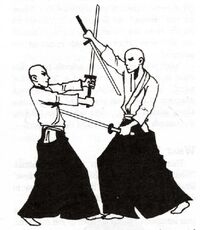
Niten
Niten was an essay on the way of two swords written by Mirumoto Hojatsu, based on the teachings of his adoptive father Mirumoto and his own skills. Niten means "two swords", "two heavens" or "two swords fall from heaven", and is most commonly referred to as the daisho technique outside of the Dragon Clan. The original text was written without sections by Hojatsu, but his son-in-law Mirumoto Kijome divided the text into sections and named them. Some scholars feel that Kijome's aid diluted the text, but others feel it helped clarify a bulky document.[1]
Niten[]
Stance[]
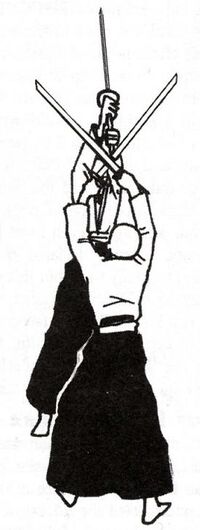
Niten
The stance used in the Niten technique should never change, in times of war or peace. It should always feel natural, and the way you stand with the sword in your hands is the same way you stand with a tea cup in your hands. If you fight as you would stand normally, your mind does not need to shift to be ready. The word used by Mirumoto for stance was kamae, and when two samurai would face each other one would say "show me your kamae". A perceptive samurai could then gauge which school the opponent had trained with by observing the other's stance.[2]
What You Show[]
There are two concepts developed by Shinsei that are a part of Niten. "What you Show" and "What you do not Show". Strategy is nothing more than deception, and the truth will be revealed at the end in the killing. Niten teaches to practice showing something other than your true intentions, and practice it as often as possible. That way, when it is time to draw the blade the mind will do it automatically.[2]
Seeing the Surface[]
Another teaching of Niten is to see through other's facades. It teaches you to see what you are not meant to see. A mans eyes can lie, so watch his shoulders, his belly and his breathing. A man can fool you with any one of these, but keeping a broad mind prevents you being fooled by all of them.[2]
Strike From the Spirit[]
When it comes time to strike, you must strike from the spirit. Thought is slow, but spirit has no time for hesitation. The spirit cannot be distracted. In Mirumoto's teachings he used the word ku, which has many meanings; "spirit", "emptiness" or "nothing". Combined with Shinsei's teachings that the spirit exists where there is nothing or where actions are unclouded by emotion or thought, then the idea of striking from the spirit means to do so without emotion or perception. [3]
Let Him Go By[]
Niten teaches that when an opponent moves with great urgency and strength merely let him go by. A side step is much quicker than a charge, and it leaves you in a position where negotiation means nothing. [4]
Knowing[]
When the spirit is clear and in tune with the elements, your true perception will be with mushin, and your spirit will be one with the universe. Then you will learn your opponent's every desire. "Mushin" means "no-thought" or "no-mind", and when one is no-mind one's spirit will be free to act. At the point of becoming mushin, a samurai is in touch with all the elements and the cosmic order. He knows his enemy better than he knows himself, for his enemy is limited by his own perceptions. Some refer to this state as "kime" or "kiho", where one focuses ones ki, or life force.[4]
The River Sword[]
Niten teaches to be like the river, ever flowing with no beginning or end. One movement leads to another, and the river can flow in all directions at once. This teaches that there is more to a duel than just a single strike.[4]
The Virtue of Walking[]
Where many schools teach a secret stepping techniqe, Niten does not. There are no secret techniques in Niten, all movements are natural.[4]
The Five Positions[]
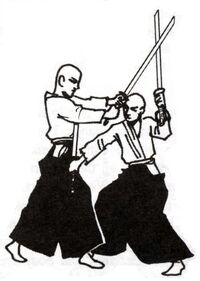
Niten
There are five positions in Niten, one for each of the elements. All these positions are an opportunity to cut, and when you take one of these positions allow your sword to meet your opponent's, and use his own momentum as your own. At every moment there is an opportunity to strike.[4]
The First Position[]
"The sword falls easily at your belly with its tip pointed at your opponent's throat. The legs are spread comfortably and firmly. Both feet are flat so you may move when you wish. Never move when you must, only when you wish. The short sword is at your side, resting easily. Your enemy's confidence will be put asunder by your casual confidence."[4]
The Second Position[]
"The sword is lifted high and falls down upon your opponent. Many think the strength of their arms is what cuts. They are wrong. The sword cuts. The wrists cut. Never the arms. The second sword is sideways across the chest to intercept the enemy's cut, then swing about, using the speed of his cut."[4]
The Third Position[]
"The sword is low and against the left leg. As the opponent strikes, we raise our sword and let his arms fall into its bite while we step aside. The opponent cuts. We step aside."[4]
The Fourth Position[]
"The sword is low and against the right leg. As the opponent strikes we move as if we are dedicated to the Third Position. He will guard appropriately, and as he does, our wrists bend like water and his head is free from his shoulders while our short sword cuts down on his sword for certainty's sake. Show one thing, be intent on another. This is the Way."[4]
The Fifth Position[]
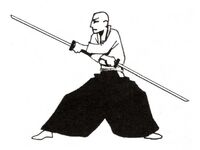
The Fifth Position
"The sword is held behind us and the short sword is before us, resting lightly on our belt and we wait for his motion. If you perform this correctly, you will never need to move. The opponent will see your stance and he will know that you know the Way. Sometimes victory is won without a single drop of blood."[5]
The Five Enemies[]
Your enemy can be known by his weaknesses. The Vain enemy will be fooled with humility. The Negligent enemy can be defeated with detail. The Angry enemy can be drawn off balance. The Exhaustible enemy tires himself quickly. The Cowardly enemy defeats himself. Learn these and you will never be defeated.[6]
Timing and Rhythm[]
There is a big difference between timing and rhythm. Many schools teach rhythm, and their techniques are like music in beats and tempo. Niten teaches timing, striking between the moments when the opponent is counting their beats. If you watch your opponent carefully, he will reveal his timing to you. Strike when his timing will prevent him from acting, and strike when your opponent believes you cannot. Show him weakness and he will charge, and that is when you have him. Learn to count, and understand his rhythm. If he breathes on one, prepares on two and strikes on three, you must strike between one and two.[6]
Three Alternatives[]
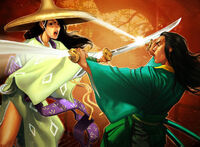
Niten Duelist
When you and your opponent fight, there are only three alternatives. If he strikes first, kill him. If you strike first, kill him. If you both strike at the same time, kill him.[6]
To Know[]
Do not believe you can win, but know it. One of Mirumoto Hojatsu's duels was against a man named Ujimona. After successfully winning, Hojatsu said that Ujimona had been the better swordsman. That his skill and technique had been better. Kijome asked how that was the case if he still won. Hojatsu replied that he knew he could win, but Ujimona had not. It is only so far that skill and technique can carry you. When they cannot carry you further, you must rely on your knowledge that you can never be defeated to survive. A single shadow of doubt will be your downfall.[6]
Notable Quotes[]
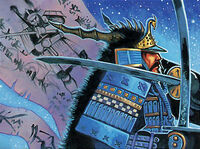
A follower of the Niten Style
- “All the Heavens will stand still for the focused mind.” [7]
- “If there is ever a single shadow of doubt, you will fail and you will die.” [8]
- “Amaterasu gave me two hands to serve my lord. Am I so proud that I will only use one?” [9]
- “There may be a hundred stances and sword positions, but you win with just one.” [10]
- “A sword is a weapon made for killing, but the intent of the daisho is not to take life, but to punish the wicked.” [11]
- “I do not believe I can win, I know I will.” [12]
- “When you engage the enemy, there are three alternatives. [13] If he attacks first, kill him. If you attack first, kill him. If you attack at once, kill him.” [12]
- “When the enemy charges you with strength and urgency, let him go by.” [14]
- “Your belly can perceive things your mind cannot. It can tell you how to act, even before the threat has appeared. A samurai trusts his belly. This is called 'Haragei'.” [15]
- “If my opponent breathes on one, draws on two, and strikes on three, then I aim to strike between two and three. Know your opponent’s rhythm and strike when he cannot.” [16]
- “Disrupt your enemy's rhythm, and he cannot recover. Strike when his timing does not allow him action. Strike when he thinks you cannot.” [17]
- “There are those who believe a single strike solves the duel. This is not so. What solves the duel comes before the strike.” [18]
- “When the decision to attack has been made, embrace the fire and strike from it. In this way you shall unbalance your enemy. You can seem strong and keep the fire in reserve, overwhelming him at the moment of striking. Or you can overwhelm your opponent from beginning to end while embracing the fire. Your enemy will know defeat before the first blow is struck.” [19]
- “When fighting one against many, draw both swords and meet first those who would attack first.” [20]
- “I do not believe I can win, I know I will.” [13]
- “Every moment you are not within your estate, you are in danger. And sometimes even this is not a certainty.” [21]
- “Arm yourself however you can. If one carries oneself with honor, there is no shame in defending one's lord.” [22]
- “The spear, the bow, the staff. Each offers something the others don't. But the sword is eternal.” [23]
- “When you take up the sword, you must feel intent on cutting the enemy.” [24]
What You Show[]
There are two concepts taught by Shinsei: “What you show” and “What you do not show.” Strategy is nothing more than knowing how to deceive. Truth is in the killing.
Practice showing something different than your intentions. Practice as often as you can. Then, when the need arises, you can do it without effort or concentration. When it is time to draw the sword, your mind should be on nothing else. Hold your swords out of position, to show your ignorance or vainglory, and anticipate his half-hearted attack. [25]
Seeing the Surface[]
Do not be deceived by the surface. Learn to see what you are not meant to see. Watch what your opponent cannot hide from you. Do not look at his eyes. A man can always lie with his eyes. Watch his shoulders, his belly, his breathing. Watch all of these. Keep a broad mind. A man can fool you with one, but if your mind is broad, he cannot fool you with all of them. You must practice this diligently. [25]
Popularity[]
In the year 47 the Dragon Clan presented a copy of Niten to the Emperor Hantei Genji. He encouraged the Dragon to copy and distribute the book around the nascent Empire. [26] In 1200 the Dragon Clan Champion Mirumoto Shikei ordered that every student of Niten would carry a copy at all times. [27]
External Links[]
- Mirumoto's 'Niten' (Honor Bound)
References
- ↑ Way of the Dragon p. 27
- ↑ 2.0 2.1 2.2 Way of the Dragon p. 28
- ↑ Way of the Dragon pp. 28-29
- ↑ 4.0 4.1 4.2 4.3 4.4 4.5 4.6 4.7 4.8 Way of the Dragon p. 29
- ↑ Way of the Dragon pp. 29-30
- ↑ 6.0 6.1 6.2 6.3 Way of the Dragon p. 30
- ↑ Time of the Void, p. 81
- ↑ Mirumoto Satsu (Scorpion Clan Coup, Scroll 3)
- ↑ Wakizashi (Jade flavor)
- ↑ Sword Saint Shrine (The Heaven's Will flavor)
- ↑ Way of the Samurai, p. 6
- ↑ 12.0 12.1 Way of the Samurai, p. 33
- ↑ 13.0 13.1 Book of Fire, p. 26
- ↑ Rokugan, p. 52
- ↑ Trusting Instinct (Torn Asunder flavor)
- ↑ Disrupting the Rhythm (Ivory flavor)
- ↑ Breaking the Rhythm (Aftermath flavor)
- ↑ Mirumoto Takanori (The Coming Storm flavor)
- ↑ Book of Fire, p. 20
- ↑ Book of Fire, p. 25
- ↑ Assassin's Strike (Twenty Festivals flavor)
- ↑ Grasp the Swords (Twenty Festivals flavor)
- ↑ Versatile Blade (Twenty Festivals flavor)
- ↑ Fire and Stones Cut (Promotional flavor)
- ↑ 25.0 25.1 Great Clans, p. 77
- ↑ Imperial Histories 2, p. 33
- ↑ Spring Kotei 2015 Fiction Act 1: Opening Moves, Day 4, by Chris Hand, Maxime Lemaire, Mari Murdock, Fred Wan, and Robert Denton
 |
This Dragon Clan related article is a stub. That means that it has been started, but is incomplete. You can help by adding to the information here. |
